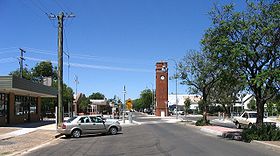Wee Waa
| Wee Waa | |||||||
|---|---|---|---|---|---|---|---|
 Main street of Wee Waa |
|||||||
|
|||||||
|
|||||||
|
|||||||
|
|||||||
|
|
|||||||
Wee Waa (pronounced: Wee War ) is a city in the northeast of the Australian state of New South Wales . It is located on the northwest slopes of the New England highlands , about 40 km west-northwest of Narrabri , about 130 km east-southeast of Walgett and 571 kom northwest of Sydney , on the Namoi River . The city is part of the Narrabri Shire Local Government Area and had a population of 1,632 at the 2016 census, of which 19.7% are Aboriginal .
history
The name of the city comes from the language of the Kamilaroi , the local Aborigines, and means 'roasting fire' in German.
In 1837 George Hobler was the first European to settle on the pastureland around the later Wee Waa and a settlement developed as a result. It became an administrative center as early as the late 1840s. In 1847 a police station was opened and court hearings were held. The first post office came two years later. Wee Waa is the oldest town in the area and the birthplace of the cotton industry in Australia.
It was the first city directly on the Namoi River and flooding occurred regularly. Today it is protected by bank reinforcements and dams. However, in February 2012, thousands of people were trapped by the water on their farms around Wee Waa.
In 1901 the railroad from Narrabri to Walgett was extended and also ran through Wee Waa.
climate
In summer the temperatures in the area around Wee Waa range between 17 ° C and 37 ° C, in winter between 3 ° C and 17 ° C. The annual rainfall is around 635 mm.
economy
The city is considered the only “cotton capital of Australia”. It is the center of the rich farming country on the lower reaches of the Namoi River, in which the settlements Burren Junction, Pilliga and Gwabewar are located.
Every year at harvest time in April, the area is transformed into a white sea of cotton that stretches from horizon to horizon. In addition, wheat is grown and cattle are kept.
traffic
Wee Waa is located on the Kamilaroi Highway (State Route 29), 42 miles west of Narrabri and the Newell Highway ( State Route 39). The city is considered the gateway to the north of the state with its centers Walgett and Collarenebri on the Barwon River , as well as the opal fields of the Lightning Ridge and further west.
The Wee Waa train station is served by CountryLink and long-distance buses run through the city. It can also be reached daily by plane via Narrabri.
Facilities
The city has two motels, four schools, a preschool, an ABC study center, two hotels, two campsites, various restaurants and inns, an outdoor swimming pool, a beautiful 9-hole golf course, a bowling club, tennis courts, a modern sports complex, and a retirement home and a new medical center.
The sports complex also serves as Wee Waa's assembly and multi-purpose hall.
Sports
The main sport in Wee Waa is rugby . The Wee Waa Panthers play in the rugby league . Jamie Lyon played at this club before his international career and returned to him after his professional playing career with the Parramatta Eels .
Criminal cases
In 1981 rugby player Eddie Murray was murdered in the Wee Waa Police Station. The murder of this Aboriginal in police custody was later investigated, along with similar cases, by a Royal Commission.
In Wee Waa, the DNA test was used for the first time in Australia to convict a rapist.
Web links
Individual evidence
- ↑ a b Australian Bureau of Statistics : Wee Waa ( English ) In: 2016 Census QuickStats . June 27, 2017. Retrieved February 7, 2020.
- ^ Rachel Mealey: Wee Waa DNA testing could start benchmark for investigation . In: The world Today . Retrieved June 25, 2011.

